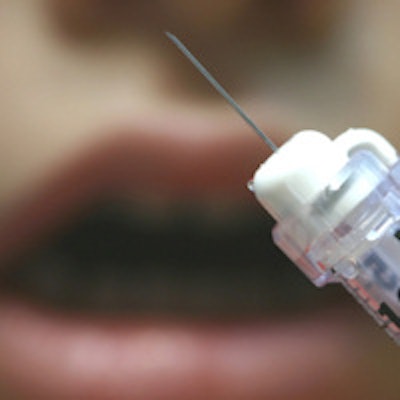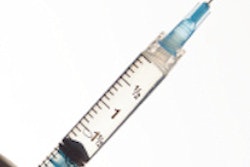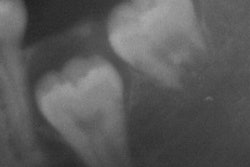
Fear of the needle has many origins, but in the case of palatal anesthetic injections, the reputation of a painful experience during dentistry is more deserved than in many other situations. Could a single buccal injection of 2% lidocaine with epinephrine be a suitable alternative?
Yes, according to a new study published in Anesthesia Progress that suggests that a buccal injection produces a better experience for patients. The study was performed by researchers from the department of oral and maxillofacial surgery at the P.D.M. Dental College & Research Institute in Bahadurgarh, India (Fall 2013, Vol. 60:3, pp. 95-98).
“Supplemental palatal injection may not be necessary.”
"The results of this study indicate that 2% lidocaine hydrochloride [HCl] with 1:200,000 epinephrine has adequate anesthesia to perform maxillary third-molar extraction," the researchers wrote. "In most cases supplemental palatal injection may not be necessary."
For many practitioners, palatal injection of an anesthetic is a common step in preparing a patient for a maxillary third-molar extraction. According to many studies reviewed by the researchers, these injections are "poorly tolerated by the majority of patients," hence the value in seeking a different anesthetic procedure.
While there are plenty of data confirming the pain that patients feel in palatal injections, data regarding the effectiveness of a locally administered anesthetic for maxillary third-molar extractions without a complementary palate injection have only recently surfaced.
The researchers selected one method and tested it rigorously to see if it could perform as well as an anesthetic palatal injection since "giving a painful injection to block a small amount of potential pain may not be the most comfortable maneuver for any patient, particularly the anxious patient," they wrote.
A direct comparison
The study included 100 participants: 65 men and 35 women with an average age of 35, and all of them needing an erupted permanent maxillary third-molar extraction. None of the patients had severe systemic disease or had an impacted molar extracted. The extractions only took place on one quadrant of the maxillary arch.
The researchers opted for lidocaine in their study, although some in the dental community may believe that there is a better choice. Articaine has a reputation as an anesthetic that diffuses in soft and hard tissue more quickly, the researchers noted, but a 2010 study was unable to substantiate this (Journal of Oral & Maxillofacial Surgery, May 2010, Vol. 68:5, pp. 1032-1037).
In the current study, for each patient, the mucobuccal fold was injected with 2 mL of 2% lidocaine HCl with 1:200,000 epinephrine under an aseptic technique, the researchers explained.
A control group of 56 men and 44 women underwent a similar procedure, but 1.75 mL of the anesthetic was injected buccally and the remaining 0.25 mL injected palatally. The extractions took place five minutes after administration of anesthetic in both groups.
While the extraction took place, an independent observer recorded the pain intensity experienced by each patient based on the Faces Pain Scale (FPS) ranging from 0-10. The patients were also asked to quantify their pain on a 100-mm visual analog scale (VAS) after extraction, with "no pain" and "absolute pain" at either end. Then the responses for both groups were compiled and compared.
Ultimately, the researchers found that no statistically significant difference in the VAS and FPS scores of the experimental and control group (p > 0.05). The pain scale values for the experimental and control groups were 0.98 and 0.80, respectively, while the mean VAS value was 5.30 for the experimental group and 4.82 for the control.
Given the similarities in pain scores, skipping the palatal injection may be worthwhile for practitioners but will require a modicum of patience.
"After the administration of the buccal injection, allow some time for diffusion of local anesthetic solution to anesthetize the palatal tissue," the researchers advised.



















